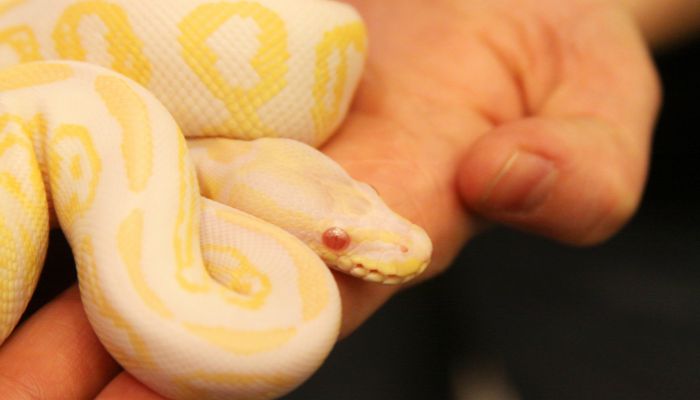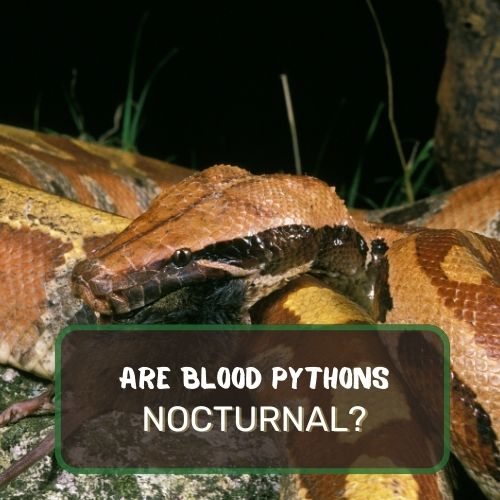Albino ball pythons are a marvel of nature, captivating many with their ethereal beauty. But do these stunning reptiles require special care?
Yes, albino ball pythons require special care due to their lack of melanin. They’re sensitive to UV rays, so avoid UVB bulbs. Their unique genetics also mean specific health considerations.
Dive into this comprehensive guide as we unravel the mysteries of their unique appearance, delve into their health considerations, and offer insights into their behavior and housing needs.
From the genetics behind their albinism to their sensitivity to light, we’ve covered all the facets to ensure your albino ball python thrives.
Let’s embark on this enlightening journey together!

Table of Contents
The Unique Appearance of Albino Ball Pythons
Have you ever wondered what makes them so unique and whether they require any special care? Let’s dive deep into the world of these fascinating creatures.
Their White Bodies, Yellow Markings, and Pink/Red Eyes
Imagine a canvas painted in pristine white, adorned with splashes of golden yellow, and eyes that seem to hold the mysteries of the universe. That’s the albino ball python for you! Their white bodies are not just a random occurrence but a result of a genetic condition called albinism.
This condition reduces the production of melanin, the pigment responsible for color in the skin, hair, and eyes. The result? A snake that looks like it’s been kissed by the sun.
Now, those pink or red eyes aren’t just for show. They’re a direct result of the lack of melanin. Without this pigment, the blood vessels behind the retina become more visible, giving the eyes their distinctive hue. It’s like nature’s own version of colored contact lenses!
The Challenges They Face in the Wild Due to Their Coloration
While their unique appearance might make them a favorite among reptile enthusiasts, it’s not always a boon in the wild. Think about it. In the dense forests and grasslands of West Africa, where ball pythons are native, being able to blend into the surroundings is crucial for survival.
A regular, wild-type ball python with its brownish-black markings can easily hide from predators. But an albino? Not so much.
Their bright white and yellow coloration makes them an easy target for predators. It’s like wearing a neon sign that says, “Hey, look at me!” in a jungle full of hungry animals. Moreover, their sensitivity to sunlight due to the lack of melanin can also pose challenges.
It’s a tough world out there for our albino friends.
Comparison with Wild-Type Ball Pythons
Wild-type ball pythons, with their earthy tones, are masters of camouflage. They can easily blend into their surroundings, making it easier for them to hunt and avoid becoming someone else’s dinner. Their dark eyes, a stark contrast to the albino’s pink/red ones, are better adapted to the bright African sun.
But it’s not just about appearances. Wild-type ball pythons have evolved over millions of years to be perfectly suited to their environment. Their coloration, behavior, and even their diet are all a result of this evolution. Albinos, on the other hand, are a genetic variation, a twist of nature that makes them stand out.
The Lack of Melanin
Melanin is like the body’s natural sunscreen. It protects the skin from the harmful effects of UV rays. But in albino ball pythons, this protective shield is missing. This means they’re more susceptible to sunburns and other UV-related issues. It’s like going to the beach without sunscreen on a scorching summer day!
The Genetics Behind Albinism in Snakes
Albinism isn’t unique to ball pythons. It’s found in various animals, from humans to birds. It’s a genetic condition where an individual inherits two copies of a mutated gene, one from each parent. This mutation affects the production of melanin.
In ball pythons, the albino trait is a simple recessive one. This means that both parents must carry the albino gene for their offspring to be albino. It’s like a genetic lottery, and the albino ball python is the jackpot!

Health Considerations for Albino Ball Pythons
Their unique genetic makeup does come with certain health considerations. Let’s delve into the health aspects of these beautiful creatures.
Sensitivity to UV Rays and the Implications for Their Care
Remember those captivating pink/red eyes we talked about? Well, they’re not just for show. Due to the lack of melanin, albino ball pythons are more sensitive to UV rays.
In the wild, this could be a real challenge, but in captivity, it means we need to be extra cautious about their exposure to direct sunlight or UVB bulbs. Prolonged exposure can lead to eye issues and even sunburns on their delicate skin.
Known Health Issues Specific to Albinos
Apart from their UV sensitivity, albino ball pythons can be prone to certain skin conditions due to their lack of pigmentation. This includes minor irritations or inflammations if not housed in the right environment. Their eyes can also be more susceptible to infections if not cared for properly.
General Health Issues in Ball Pythons and Prevention
Like all ball pythons, albinos can face issues like respiratory infections, mites, and digestive problems. Regular check-ups, maintaining a clean habitat, and ensuring a balanced diet can go a long way in preventing these issues. Remember, a happy snake is a healthy snake!

Proper Care for Albino Ball Pythons
Caring for an albino ball python isn’t rocket science, but it does require a bit of knowledge and a lot of love. Let’s explore the essentials of their care.
Importance of Avoiding UVB Bulbs
Given their sensitivity to UV rays, it’s crucial to avoid using UVB bulbs in their enclosures. These bulbs can cause more harm than good, leading to potential eye and skin issues. Instead, opt for regular heating lamps to maintain the right temperature.
Ideal Temperature and Humidity Levels
Albino ball pythons thrive in temperatures between 75°F to 90°F. It’s essential to maintain a temperature gradient in their enclosure, with a warmer basking area and a cooler resting spot. As for humidity, keeping it between 50% to 60% is ideal. This helps in shedding and overall skin health.
Diet and Feeding Habits
Just like their wild-type counterparts, albino ball pythons are carnivores. They primarily feed on rodents like mice and rats. Younger pythons might prefer smaller prey like pinkie mice, while adults can handle larger rats.
It’s essential to feed them appropriately sized prey, roughly equivalent to the widest part of their body. Remember, overfeeding can lead to obesity, so it’s all about balance!

Housing and Enclosure Tips
Ah, home sweet home! Just like us, albino ball pythons need a comfortable and safe space to thrive. Let’s explore the ideal housing conditions for these unique reptiles.
Recommended Size and Type of Enclosure
Size matters, especially when it comes to housing your albino ball python. For a juvenile, a 10-gallon tank might suffice, but as they grow, they’ll need more space. An adult albino ball python is best housed in a 40-gallon tank or enclosure.
Glass terrariums are popular, but PVC enclosures can offer better humidity and temperature control. Remember, they need space to move, explore, and stretch out.
Importance of Hides and Décor
Imagine living in an open field with nowhere to hide. Sounds stressful, right? Ball pythons, being secretive creatures, love their privacy. Providing multiple hides, one on the warmer side and one on the cooler side, is essential. This gives them a sense of security and reduces stress.
As for décor, think of branches, rocks, and artificial plants. Not only do they make the enclosure aesthetically pleasing, but they also offer enrichment for your snake.
Substrate Choices and Their Benefits
The substrate is more than just the floor of the enclosure; it plays a crucial role in maintaining humidity. Choices like cypress mulch and coconut coir are excellent as they retain moisture well. Avoid cedar or pine, as they can be harmful. A good substrate makes cleaning easier and provides a natural feel for your python.

Behavior and Handling of Albino Ball Pythons
Albino ball pythons, with their unique genetics, have some quirks when it comes to behavior and handling. Let’s unravel the mysteries of their behavior.
Typical Behaviors to Expect
Albino ball pythons are generally docile and easy-going. However, they can be shy and might spend a lot of time hiding, especially when they’re new to an environment. Don’t be alarmed if they curl into a tight ball when disturbed; it’s their natural defense mechanism and the reason behind their name!
Handling Tips and Precautions
While they’re generally calm, it’s essential to handle them with care. Always approach them slowly, avoiding sudden movements. Start with short handling sessions and gradually increase the duration as they get accustomed. Remember, right after feeding or during shedding, it’s best to leave them be.
Understanding Their Sensitivity Due to Poor Eyesight
Those mesmerizing pink/red eyes come with a catch – reduced eyesight. Albino ball pythons rely more on their sense of smell and heat-sensing pits. This means they might be more startled by sudden movements. Always be gentle, and understand that their world is a bit different from ours.
Summary
You’ve journeyed through the captivating world of albino ball pythons, discovering their unique appearance, health considerations, and care requirements.
These creatures, with their mesmerizing beauty, do have specific needs, but with knowledge and dedication, they can thrive in your care. Remember, every challenge they present is an opportunity for you to learn and grow as a caretaker.
Embrace the experience, and you’ll find that caring for an albino ball python is not just a responsibility, but a rewarding adventure. You’ve got this!
FAQ
Navigating the world of albino ball pythons can be filled with questions. Let’s tackle some of the most frequently asked ones!
Do Albino Ball Pythons Need Light?
Yes, but with a twist! While they do benefit from a regular day-night cycle, it’s essential to avoid UVB lights due to their sensitivity. Instead, use regular heating lamps to maintain the right temperature. Ambient room light is usually sufficient for their day-night cycle.
Are Albino Ball Pythons Hard to Take Care Of?
Not really! With the right knowledge and a bit of dedication, caring for an albino ball python is quite straightforward. They have specific needs due to their albinism, but once you’ve got the basics down, they’re as easy to care for as any other pet snake.
What Do Albino Ball Pythons Need?
A comfortable enclosure, the right temperature and humidity levels, a balanced diet, and lots of love! Oh, and don’t forget the hides and décor to make them feel at home.
Are Albino Pythons Harmless?
Absolutely! Albino ball pythons are known for their docile nature. They’re non-venomous and generally very calm. However, like all animals, it’s essential to handle them with respect and care.




0 Comments